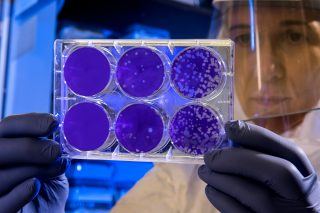Africa July 2022. Currently, umbilical cord blood stem cells are being used to treat blood cancers, inherited blood disorders, and certain metabolic and immune disorders. These diseases are prominent in South Africa, yet access to cord blood stem cells is limited.
Dr. Yvonne Holt is Chief Medical Officer of Netcells Stem Cell Bank – the largest established private umbilical cord blood bank in Africa. Dr. Holt acknowledges that great strides have been made internationally with regard to cord blood banking and stem cell treatment. However, its use is still not fully accessible in South Africa.
July is Cord Blood Awareness Month. The company aims to educate the public regarding the importance of umbilical cord blood storage and how it can save lives.
Cord Blood Is Vital For Longevity
Dr. Holt explains that having access to cord blood provides an important source of stem cells, which can treat many life-threatening illnesses such as blood disorders such as Thalassaemia, sickle cell anemia, aplastic anemia; cancers such as leukemia, lymphoma, and solid tumors of childhood; metabolic and immune disorders.
The umbilical cord blood stem cells are mainly haematopoietic (blood-forming) stem cells. They are therefore used in these illnesses to create new, healthy bone marrow after chemotherapy.
“Internationally, cord blood stem cells can be sourced from public banks that collect cord blood from voluntary donations. Since we don’t have a local public stem cell bank in South Africa, it puts South African patients at a greater disadvantage, as bringing in cord blood units from overseas is prohibitively expensive.”
Banking stem cells
In the past, the costs associated with private stem cell banking has posed a barrier. However, the launch of Netcells’ Community Stem Cell Bank in partnership with the South African Bone Marrow Registry (SABMR) – the only bank of its kind in the country – offers parents the opportunity to store their baby’s cord blood at a significantly reduced rate.
The cord blood unit can then be used by the family themselves. Alternatively, it can be used by someone else in the community who may need a lifesaving transplant. If the cord blood unit is utilized by someone else, then all costs associated with the storage are refunded to the family.
“This will greatly improve transplant options for SA’s diverse demographic, as it can be difficult to find a bone marrow stem cell match for patients of African origin given the lack of donors from these communities.
It’s important to educate all South Africans regarding the importance of building a donor base that can serve all members of our community,” says Dr Holt.
Alternatively, parents can choose to go the private cord blood banking route. They will pay the full price to have their baby’s cord unit stored exclusively for their child or family’s use.
Processing cord blood
Dr. Holt says the process of collecting blood from a newborn’s umbilical cord, is easy and painless.
Once collected, it is tested, frozen, and stored in the cord blood bank.
“Cord blood stem cells are used to replace dysfunctional blood-producing cells in bone marrow with healthy new cells. Once diseased cells are destroyed by chemotherapy and irradiation, new stem cells are transplanted into the patient to restore normal functioning of the bone marrow.”
Netcells also runs a sibling cord blood donor program, called Families of Hope. It aims to improve poor and disadvantaged families’ access to stem cell banking. This is especially important if they have a child with a stem cell-treatable disease.
“If a disadvantaged child requires a bone marrow stem cell transplant, and their mother is expecting a child from the same father, we will facilitate the collection of the cord blood, process, test and store the cord blood until it is needed for transplant in the ill sibling.”
“In this way, we hope to expand the opportunity to families who are faced with a life-threatening disease but cannot afford to save their baby’s precious stem cells at birth,” she says.
Medical advances with cord blood
The first cord blood transplant was done in the late 80s. Since then, there have been remarkable advances. In fact, there have been more than 40 000 cord blood transplants done worldwide.
“Cord blood stem cells are also proving useful in new areas of regenerative medicine to potentially treat cerebral palsy, autism, and Type 1 diabetes. If the potential of stem cell research is realised, it could lead to breakthroughs in treatments for many diseases we face today.
“Researchers are also continuing to look for ways to improve transplant success and to increase the number of stem cells collected from each cord, which could potentially reduce the costs associated with cord blood transplants in the future.”
Cord blood is by no means regarded as a miracle cure. However, it provides an important source of stem cells to treat several life-threatening illnesses. It also has the potential to treat many more common diseases in the future as technology progresses.
For now, collecting your baby’s stem cells remains a valuable insurance policy for you and your loved ones.
For more info regarding cord blood banking, visit Next Biosciences.
About Dr. Yvonne Holt

Dr. Yvonne Holt
Yvonne Holt graduated from the University of the Witwatersrand in 1997 with a Bachelor in Medicine and Surgery (MBBCH Wits). Dr. Holt worked as a Medical Officer in the departments of Paediatrics and Obstetrics and Gynaecology for 4 years after graduation. She obtained a Diploma in Child Health (DCH) during this time.
In 2006, Dr. Holt’s interest in the fields of Obstetrics and Gynaecology, Paediatrics, and stem cell technology brought her to a new career path. She joined Next Biosciences as Medical Director.
In this capacity, Yvonne is responsible for the medical development of the stem cell program at Next Biosciences. She also highlights the benefits of this new technology. In 2011, Yvonne completed a 2 year, internationally recognized Diploma in Transfusion Medicine through the University of Bloemfontein.




![women [longevity live]](https://longevitylive.com/wp-content/uploads/2020/01/photo-of-women-walking-down-the-street-1116984-100x100.jpg)










